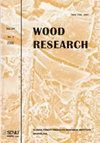后农业用地上生长的山毛榉、桦树和橡树的质量
IF 1
4区 农林科学
Q3 MATERIALS SCIENCE, PAPER & WOOD
引用次数: 2
摘要
本研究评估了原农业用地上用于木材生产的桦木、山毛榉和橡树的质量。所选树种样地均具有相同的森林生境类型。所有被测量的树木都已到了砍伐的年龄。因此,山毛榉的树龄超过120岁,桦树的树龄超过70岁,橡树的树龄超过140岁。在每个样地,测量所有树木相同的形态特征:胸径、树高、第一死枝高度、第一活枝高度和树冠基部。根据收集到的数据,计算出适合工业用途的主干长度和百分比。一般来说,原农业用地的桦树和山毛榉树较高,但树干较薄,当在橡树中观察到反向观察。从以前的农业用地的树干有app. 7%缩短无结树干部分。森林与原农业用地的差异最大的是橡树(14%),其次是山毛榉(5%)和桦树(1%)。考虑到树木的形态特征和质量指标,我们表明所有树种都可以用于以前的农业用地造林,为未来的工业用途生产优质木材。但需要注意的是,一般情况下,原农用地的计算立木量较低。本文章由计算机程序翻译,如有差异,请以英文原文为准。
QUALITY OF BEECH, BIRCH AND OAK WOOD FROM STANDS GROWING ON POST-AGRICULTURAL LANDS
This study assessed the quality of birch, beech, and oak for timber production on former agricultural land. All sample plots for the selected species had the same forest habitat type. All measured trees had already reached the age of felling. Thus, beech was over 120 years old, birch was over 70 years old, and oak was over 140 years old. On each plot, the same morphological features were measured for all trees: diameter at breast height, tree height, height of the first dead branch, height of the first live branch, and crown base. Based on collected data the length and percentage of the trunk suitable for industrial purposes were calculated. In general birch and beech trees from former agricultural land were higher, but had thinner trunks, when in oak reverse observation were noticed. Tree trunks from former agricultural lands have app. 7% shorter knots-free trunk section. The bigger different between forest and former agricultural land was noticed in case of the oak – 14%, then beech – 5% and birch – 1%. Considering the morphological characteristics of the trees and quality indicators, we showed that all species could be used for the afforestation of former agricultural lands to produce high-quality wood for future industrial purposes. However, it should be noticed, that in general calculated standing volume was lower on former agricultural land.
求助全文
通过发布文献求助,成功后即可免费获取论文全文。
去求助
来源期刊

Wood Research
工程技术-材料科学:纸与木材
CiteScore
2.40
自引率
15.40%
发文量
81
审稿时长
5.4 months
期刊介绍:
Wood Research publishes original papers aimed at recent advances in all branches of wood science (biology, chemistry, wood physics and mechanics, mechanical and chemical processing etc.). Submission of the manuscript implies that it has not been published before and it is not under consideration for publication elsewhere.
 求助内容:
求助内容: 应助结果提醒方式:
应助结果提醒方式:


